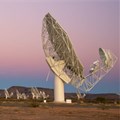The age-old question of whether we are alone in the universe has captivated humanity for centuries and was posed at the International Astronomy Union general assembly. While the search for extraterrestrial life has traditionally focused on finding biological signatures, a growing field of research is exploring the possibility of detecting technological signs of advanced civilizations. Dr Andrew Siemion, is an astrophysicist and the Director of the Berkeley SETI Research Centre explained that these signs, known as techno signatures, could range from radio signals to megastructures built around stars.

The MeerKAT radio telescope in the Northern Cape is an important part of the search for alien life in the universe.
“A techno signature is any detectable manifestation of technology, anything that we can see that conveys the presence of an advanced civilisation that created the technology,” explains Seimion.
“Most of the techno signatures that are discussed fall into the category of remote sensing.”
In recent years, research has gained significant traction, with major telescopes around the world dedicating resources to the search.
The Breakthrough Listen initiative, the largest techno signature research program globally, is using powerful telescopes like MeerKAT in South Africa to survey millions of stars for signs of intelligent life.
“Our group has actually been working with Sarao, the South African Radio Astronomy Observatory, for almost two decades now, at this point, helping to develop the digital instruments for the telescope,” he says.
“For about the last eight or nine years we’ve been involved developing the world's most powerful radio techno signature search machine that operates on MeerKAT.”
Promising new technologies
Advancements in technology are revolutionising the search for techno signatures.
The upcoming Square Kilometer Array (SKA) observatory, which will be the most powerful radio telescope ever built, will be able to detect even faint signals from distant planets.

Dr Andrew Siemion is an astrophysicist and the Director of the Berkeley SETI Research Centre
The use of artificial intelligence and machine learning is also streamlining the analysis of vast amounts of data, enabling scientists to identify potential techno signatures more efficiently.
The detection of a techno signature would be a monumental discovery, confirming the existence of intelligent life beyond Earth.
It would not only answer the question of whether we are alone, but also provide insights into the potential futures of our own civilization.
The search for techno signatures is a testament to humanity's curiosity and our relentless pursuit of knowledge about the universe and our place within it.
A long road ahead
“We haven't found aliens yet. But a couple of years ago, we had a very exciting candidate signal called Breakthrough Listen Candidate 1,” Seimion continues.
“In this case, it was a nearby star, Proxima Centauri… The drift in frequency is something that we would expect from some unknown relative acceleration between the observatory and a rotating exoplanet, and it took us quite some time in order to follow up on this.”
“But ultimately, we were able to identify it as a part of a class of signals at sort of similar frequencies or related frequencies and conclusively determined to be interference.”
With new technologies and innovative approaches, scientists are hopeful that we may one day detect a signal from an advanced civilization, ushering in a new era of understanding about our place in the cosmos.
Scientific rigour
“It (BLC1) demonstrated and allowed us to test our ability to conduct follow-up and to really dig into a signal's origin in great detail,” he concludes.
“But the fact that we were able to publish these results in a premier journal is also something new to the field.”
He also said that it was a great demonstration of the strides that the field had made over the last decade or so in terms of scientific rigour.
The search for techno signatures is a journey of exploration, a quest to answer one of the most profound questions of our existence.
And as we continue to scan the skies, we remain hopeful that one day, we may find evidence that we are not alone.











































